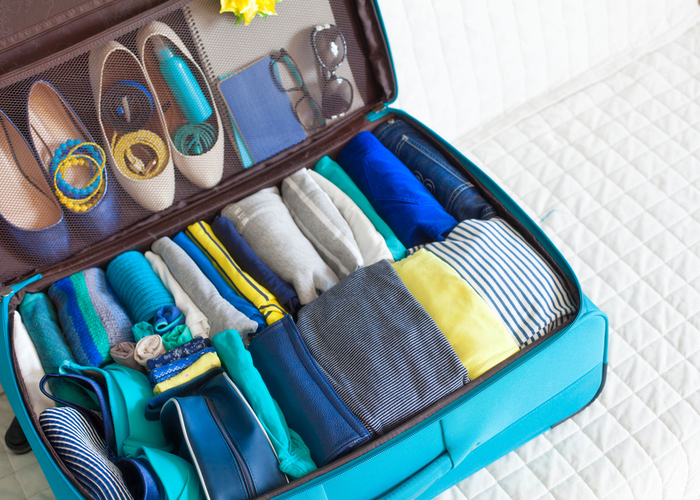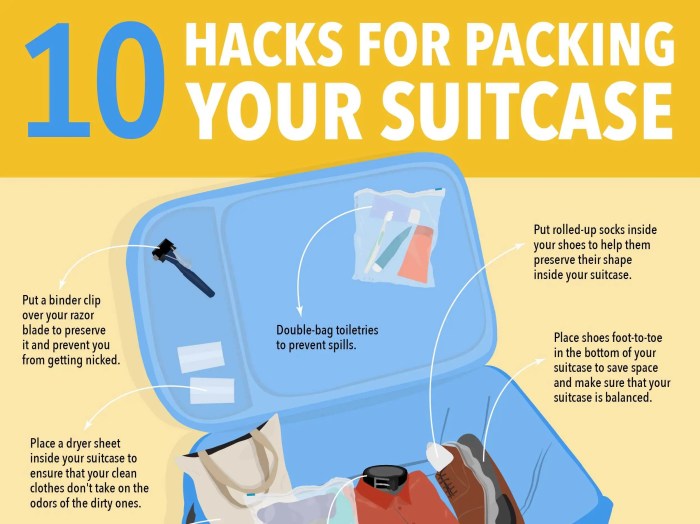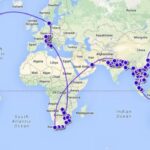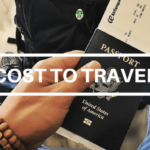Suitcase Packing Hacks: Tired of overflowing suitcases and frantic airport dashes? Mastering the art of packing isn’t about brute force; it’s about strategy. This guide unveils the secrets to maximizing space, minimizing weight, and ensuring a smooth, stress-free travel experience. We’ll cover everything from choosing the right luggage to packing clothes like a pro, ensuring you arrive at your destination feeling refreshed and ready for adventure, not exhausted and overwhelmed.
From rolling versus folding techniques to utilizing packing cubes and compression bags, we’ll explore a range of methods to optimize your luggage. We’ll delve into specific packing lists for different trip types – business, leisure, family vacations, even backpacking adventures – providing tailored strategies to fit your unique needs. Learn how to protect fragile items, comply with airline regulations, and ultimately, travel smarter, not harder.
Maximizing Space in a Suitcase
Packing efficiently is crucial for stress-free travel. A well-packed suitcase maximizes space, minimizes wrinkles, and ensures you have everything you need without exceeding weight limits. Mastering these techniques can transform your travel experience.
Suitcase Packing Techniques
Several techniques significantly impact how much you can fit into your suitcase. The most effective methods focus on eliminating wasted space and utilizing every cubic inch. Consider these proven strategies for optimal packing:
The Rolling Method: This technique involves tightly rolling clothes into compact cylinders. This minimizes wrinkles and creates more space compared to traditional folding. Begin by laying the garment flat, then roll it tightly from one end to the other, securing it with a rubber band if necessary. This method works particularly well for softer fabrics like t-shirts and sweaters.
You’ll find that you can pack significantly more clothing this way.
The Folding Method: While rolling is generally preferred for space optimization, folding remains a viable option for certain items. For shirts and blouses, fold them neatly in half, then in thirds or quarters, depending on the size and the space available. This method is best for items that are more prone to creasing if rolled, such as dress shirts or linen pants.
Organize folded items to fit snugly together, filling gaps efficiently.
Rolling versus Folding Clothes: A Step-by-Step Guide
The choice between rolling and folding depends largely on the type of clothing and personal preference.
Step-by-Step Rolling: 1. Lay the garment flat. 2. Starting from one end, roll it tightly into a cylinder. 3.
Secure with a rubber band (optional). 4. Place the rolled garment in your suitcase.
Step-by-Step Folding: 1. Lay the garment flat. 2. Fold it in half, then in thirds or quarters. 3.
Place the folded garment in your suitcase, utilizing space efficiently.
Efficient Shoe Packing
Shoes occupy considerable space and can contribute to wrinkling other items. Optimize shoe packing with these tips:
Stuff socks and underwear inside your shoes. This maximizes the space inside the shoes and prevents them from collapsing. Place shoes at the bottom of the suitcase to create a stable base for other items, protecting them from being crushed. Use shoe bags to keep them clean and organized.
Comparison of Packing Cubes
Packing cubes are versatile organizers that compress clothing and maintain order within your suitcase. Different types offer varying benefits.
| Type of Packing Cube | Material | Size Options | Pros/Cons |
|---|---|---|---|
| Standard Packing Cube | Nylon or Polyester | Small, Medium, Large | Pros: Lightweight, affordable, versatile. Cons: May not compress clothing as effectively as compression cubes. |
| Compression Packing Cube | Nylon or Polyester with compression zippers | Small, Medium, Large | Pros: Significantly reduces clothing volume. Cons: Can be more expensive, may be more difficult to pack and unpack. |
| Mesh Packing Cube | Mesh fabric | Small, Medium, Large | Pros: Allows for better airflow, easy to see contents. Cons: Offers less compression than other types. |
| Waterproof Packing Cube | Waterproof nylon or TPU | Various sizes | Pros: Protects clothes from moisture. Cons: Usually heavier and less breathable than standard cubes. |
Choosing the Right Suitcase and Packing Accessories

Selecting the perfect suitcase and employing smart packing accessories are crucial for efficient travel. The right combination can significantly reduce stress and maximize your packing potential, leading to a smoother and more enjoyable trip. Failing to consider these factors can result in overpacking, damaged belongings, and unnecessary hassle. Let’s delve into the specifics.
Hard Shell vs. Soft Shell Suitcases
Hard shell suitcases, typically made from polycarbonate or ABS plastic, offer superior protection against impacts and weather. Their rigid structure safeguards your belongings from damage during transit. However, they often lack flexibility in terms of packing capacity and can be heavier than their soft shell counterparts. Soft shell suitcases, usually made from nylon or polyester, are more flexible and lightweight, allowing for easier packing and potentially more capacity.
They tend to be more affordable, but they offer less protection against damage. The choice depends on your priorities: prioritizing protection necessitates a hard shell, while prioritizing lightness and cost-effectiveness points towards a soft shell.
Benefits of Packing Cubes, Compression Bags, and Other Accessories
Packing cubes are fabric containers designed to organize clothing and other items within your suitcase. They compress clothes, maximizing space and preventing wrinkles. Compression bags function similarly, using a valve to remove air and further reduce volume. These accessories provide structure, making it easier to locate items and preventing your suitcase from becoming a jumbled mess. Their use dramatically improves organization and efficiency, reducing packing time and unpacking frustration.
Think of them as internal organizers for your suitcase, similar to drawers in a dresser. For example, one cube could hold shirts, another pants, and another underwear – creating a highly organized system.
Luggage Organization Tools and Suitability for Various Travel Styles
Various luggage organization tools cater to different travel styles. For business travelers, a dedicated laptop sleeve and a portable garment bag maintain professional attire. Backpack-style luggage with multiple compartments suits adventurers, while rolling suitcases with ample storage are ideal for families. Consider the type and quantity of items you typically carry when selecting your organization tools. A frequent traveler might opt for a set of packing cubes and a toiletry bag, while a weekend getaway might only require a small packing cube and a zip-top bag for toiletries.
The key is to match your tools to your needs.
Essential Packing Accessories for a Week-Long Trip, Suitcase Packing Hacks
A week-long trip requires careful planning. The following list of essential packing accessories will ensure a smooth journey:
- Packing Cubes (at least 3-4): To organize clothing and maximize space.
- Compression Bags: To reduce the volume of bulky items like sweaters.
- Toiletry Bag: To keep toiletries separate and organized.
- Laundry Bag: To separate dirty clothes from clean ones.
- Shoe Bags: To protect shoes and keep them from soiling other items.
- Travel-sized bottles and containers: For liquids that conform to airline regulations.
These accessories provide a solid foundation for efficient packing and a more organized travel experience. Remember to choose accessories that fit your specific suitcase and travel style.
Packing Toiletries and Fragile Items: Suitcase Packing Hacks

Efficiently packing toiletries and fragile items is crucial for a stress-free trip. Leaks and breakage can ruin your belongings and your vacation. By implementing smart strategies, you can minimize these risks and maximize your packing space. This section will Artikel proven techniques for protecting your essentials and ensuring a smooth journey.
Proper packing is about more than just throwing items into a bag; it’s about strategic organization and the use of protective materials. This minimizes the risk of spills and damage, ensuring your precious items arrive at your destination intact. Think of it as a mini-logistics operation for your personal effects – a well-executed plan ensures a smooth and efficient travel experience.
Travel-Sized Toiletries and Ideal Packaging
Choosing the right containers for your toiletries is paramount. Avoid glass bottles; opt for leak-proof, TSA-approved travel containers made of durable, flexible plastic. These are readily available in various sizes at most drugstores and travel retailers. Consider using small, screw-top containers for liquids and creams to minimize the chance of spills. For example, a 3-ounce travel bottle of shampoo is ideal, as it adheres to airline regulations while offering sufficient quantity for a short trip.
Solid toiletries like bars of soap or deodorant are also excellent choices, as they eliminate the risk of liquid leakage entirely. Remember to always tightly seal the lids.
Protecting Fragile Items
Protecting fragile items like electronics and jewelry requires careful consideration. For electronics, use their original packaging whenever possible, or consider purchasing protective cases specifically designed for travel. Bubble wrap provides excellent cushioning, and soft clothing items can also be used to create a protective layer around delicate objects. For jewelry, utilize hard cases or pouches to prevent scratches and damage.
Consider placing jewelry in a zippered bag within a larger compartment to further protect it from being crushed or lost. A small, dedicated jewelry case is an excellent investment for frequent travelers.
Airline Regulations for Liquids, Creams, and Gels
Adhering to airline regulations is essential to avoid delays and confiscation of your belongings.
Understanding and following these rules is crucial for a seamless travel experience. Failure to comply can result in delays and even the discarding of your belongings at security checkpoints.
- All liquids, creams, and gels must be in containers of 3.4 ounces (100ml) or less.
- These containers must be placed inside a single, quart-sized, clear, resealable plastic bag.
- Only one quart-sized bag is allowed per passenger.
- The bag must be completely sealed.
- Place the bag separately in your carry-on luggage for easy access during security checks.
Packing efficiently isn’t just about fitting more into your suitcase; it’s about maximizing your travel experience. By implementing these suitcase packing hacks, you’ll not only save valuable space and weight but also reduce stress and travel smarter. Remember, the key is preparation and strategy. With a well-packed bag, you’ll be free to focus on what truly matters: enjoying your journey and making unforgettable memories.
So, ditch the packing stress and embrace the efficiency! Your next trip awaits.

